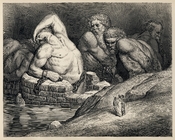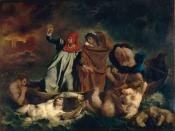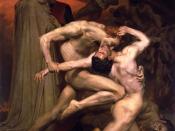The journey of Dante through Hell, in both its structure and content, symbolizes the nature of sin and punishment. The structure of the book takes the reader step by step through greater and greater sins. The content of the book shows the different punishments for sins which are symbolic of the sins themselves; it also, through its language, shows how Hell compares to life. This book was written for Christians and deals heavily with religion, but can be interpreted and learned from in an existential manner
In the Inferno, Hell is divided into nine circles. Dante progresses through each of these circles in order. Each circle represents a greater sin and, therefore, a greater punishment. This is symbolic of life. When you commit a sin or wrong action, you are then led to a greater evil. The sins you commit grow and build; you get away with an inch and then end up taking a mile.
Each canto in the book represents sinners that have gone farther and farther into their sins. As Dante progresses through Hell, he realizes the extent of wrong that a person can ultimately commit. This shows that we must recognize our sins and wrong doings before we end up in Hell, or, existentially speaking, lost in pure, dark evil. It is almost like a small lie that can grow and grow to ultimately consume your life.
In its content, the Inferno also shows the reader what a sin is really like by creating a symbolic punishment which mirrors the actual sin. Hell is a place 'where penalties are paid by those who, sowing discord, earned Hell's wages.' For example, in canto V lines 31-45, Dante writes, '[Referring to those who lusted] I came to a place where no light shown at all, bellowing...


